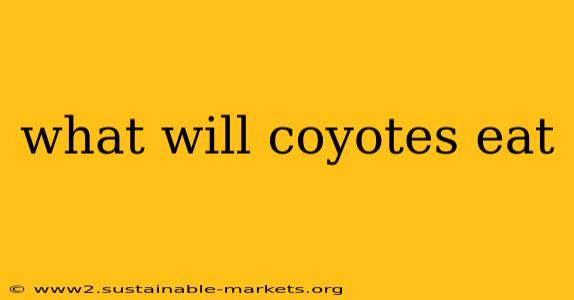Coyotes, highly adaptable and resourceful canids, boast a remarkably diverse diet. Understanding what coyotes eat is crucial for appreciating their ecological role and managing human-wildlife interactions. This comprehensive guide delves into the fascinating world of coyote foraging, exploring their prey preferences, seasonal variations in their diet, and the impact of human activities on their food sources.
Coyote Diet: A Carnivore's Menu
While often depicted as opportunistic omnivores, coyotes are primarily carnivores. Their diet centers around readily available animal prey, with the specific composition varying depending on location, season, and prey availability.
Primary Prey:
- Rodents: Coyotes are exceptionally skilled hunters of rodents like mice, rats, voles, and rabbits. These small mammals form a significant portion of their diet, especially in areas with abundant grasslands and scrublands.
- Rabbits and Hares: These lagomorphs are a staple food source, providing substantial caloric intake for coyotes. Their abundance often dictates the success of coyote populations.
- Birds: Ground-nesting birds, their eggs, and chicks are frequent targets. Coyotes will also prey on larger birds, particularly when opportunities arise.
- Reptiles and Amphibians: Lizards, snakes, frogs, and toads supplement the coyote diet, particularly during periods when other prey is scarce.
Secondary Prey:
- Deer (fawns primarily): While capable of taking down adult deer, coyotes typically target fawns or weak individuals. This prey source is more important in areas with larger deer populations.
- Larger Mammals: In certain circumstances, coyotes may opportunistically hunt larger mammals, including raccoons, skunks, and even young domestic animals like livestock (sheep, goats, poultry). However, this isn't their typical prey.
- Insects and Other Invertebrates: Although not a primary food source, insects and other invertebrates like grasshoppers and beetles can contribute to a coyote's overall caloric intake.
Seasonal Variations in Coyote Diet
The availability of different prey items fluctuates throughout the year, directly influencing a coyote's diet. For example:
- Spring and Summer: Abundant small mammals, birds, and their eggs provide a rich food source.
- Autumn: Fruits, berries, and other plant materials become more significant dietary components, supplementing the animal protein intake.
- Winter: Rodents, rabbits, and carrion (decaying animal matter) become increasingly important as other prey becomes less accessible.
The Role of Human Activities
Human activities significantly impact coyote diets and populations.
- Habitat Loss: Urban sprawl and agriculture reduce coyote habitat, limiting access to natural prey.
- Human Food Sources: Attracted to readily accessible human food waste, coyotes may become habituated to human environments, leading to conflicts. This can also lead to changes in their natural behaviors and diet.
- Rodenticide Use: The widespread use of rodenticides can indirectly affect coyotes by reducing their primary prey base. This can result in secondary poisoning through consumption of contaminated rodents.
Conclusion: Understanding the Coyote's Culinary Landscape
The coyote's diet is a dynamic reflection of its environment and adaptability. Understanding its multifaceted feeding habits is key to effective wildlife management and promoting coexistence between coyotes and humans. By respecting their role in the ecosystem and minimizing human-induced impacts, we can help ensure the long-term health and sustainability of coyote populations.

